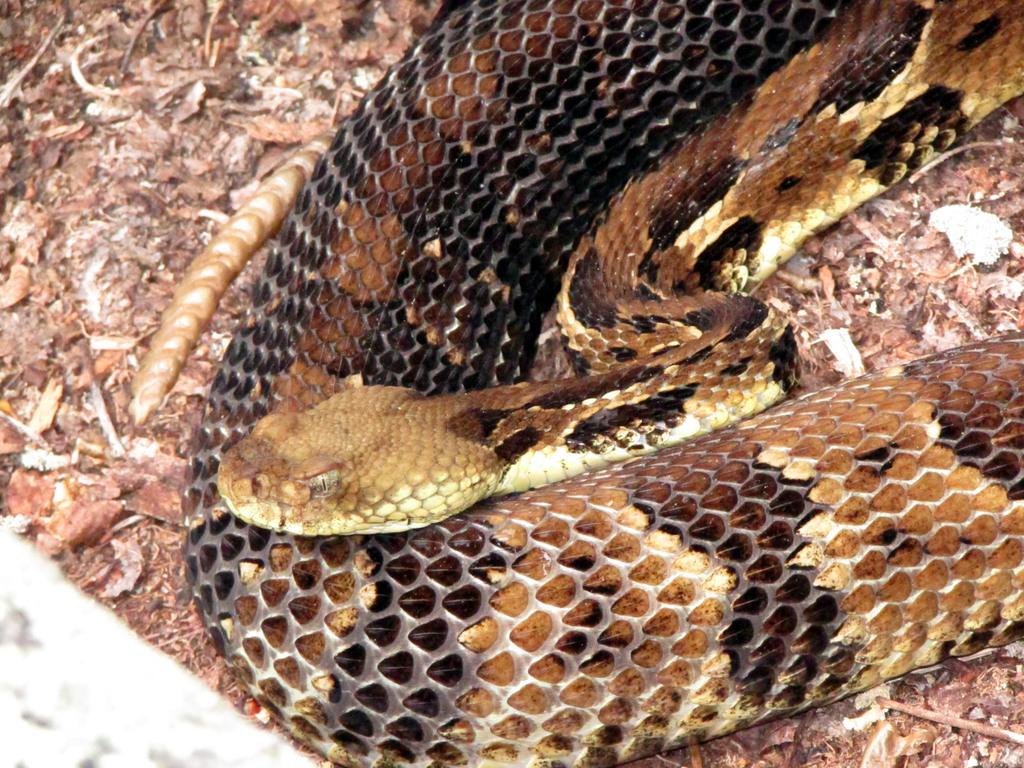Woodland Wildlife Spotlight: Timber Rattlesnake
From Spring 2023 issue of Branching Out. Subscribe to Branching Out here. Read more Woodland Wildlife Spotlights here.

Yellow phase of Timber Rattlesnake, Frederick County MD. Photo © Scot Magnotta, iNaturalist.org
From Spring 2023 issue of Branching Out. Subscribe to Branching Out here. Read more Woodland Wildlife Spotlights here.
Undoubtedly, snakes have an unpopular reputation. Perhaps it has to do with the fact that they do perfectly well without legs for locomotion. However, fish are also legless, and for many birds, it is easier to fly than to walk or run. Perhaps it’s because their cold-blooded system is alien to warm-blooded humans; but other cold-blooded species, such as frogs and turtles, don’t engender the same repulsion as snakes. Whatever the reason, humans and snakes have a grudging relationship, although that has improved in the last few decades as scientists have revealed the benefits snakes provide in a healthy ecosystem.
Maryland is home to 27 species of snakes, most of which humans rarely see in day-to-day lives. Of these, only two, the Eastern Copperhead and the Timber Rattlesnake, are pit vipers and thus dangerously venomous to humans. The latter is the subject of this issue’s profile, as it is the only snake in Maryland with a tail rattle and as it can be found in two color patterns, which can make identification challenging. The species’ yellow phase, which is the more common, features a background of yellow, grey, or brown, with dark brown to black chevrons. In the black phase, the head is black and the body features black chevrons or blotches on a background of dark brown or black. Furthermore, these shades and patterns vary from snake to snake and can exist in both males and females.
| Timber Rattlesnake Basics |
|---|

Appearance: Distinctive triangular head. Elliptical pupils in eyes. Sensory “pits” below eyes. Head much wider than neck. Both black and yellow phase colorations found in MD. Rattles on tail. Heavy body. Size: 3 feet on average; up to six feet at largest. Weight 1-3 lbs.
Lifespan: Average 16-22 years in the wild; up to 30 years. |
The timber rattlesnake is found mostly in Maryland’s four western counties (Frederick, Washington, Allegany, and Garrett), where it can find forested uplands with open areas and ridgetops for its habitat. Like many predators, it prefers to hunt by ambush, and will hide in cover such as fallen logs and leaf litter, waiting for its prey to approach. When the animal is close enough, the snake strikes and injects venom through its hollow fangs into the prey. After the bite, it releases the animal and then follows its chemical trail to consume it. The snake’s diet consists mostly of rodents and other small mammals, although they may take advantage of the opportunity to consume birds, amphibians, and other snakes. Not only does this species provide an ecological service by keeping the rodent population in check, a 2013 study by University of Maryland researchers found that a single timber rattlesnake removed up to 4,500 ticks annually from a woodland by consuming tick-bearing mammals.
Timber rattlesnakes hibernate in groups during the winter in dens below the frost line, and emerge in the warmer weather, when they can often be seen basking on warm rock faces or other exposed surfaces. They may cover a distance of up to four miles from the den during the warmer months before returning to the same den in the fall.
The species once occupied a range from southern Canada to Georgia and as far west as Wisconsin in the north and northeastern Texas in the south. A variety of circumstances, including its biology, have reduced that range significantly. Male timber rattlesnakes only reach maturity at five years of age, and females at 7-11 years. Additionally, females give birth only once every three to five years. Consequently, two-thirds of all females may reproduce only once in their lifetime. Unlike other snakes, timber rattlesnakes bear live young, up to nine at a time. Each is born with venom and a small “button” rattle on its tail. Each time the snake sheds its skin, every one to two years, it grows an additional rattle.
However, the greatest threat to the species comes from human pressures. Destruction of habitat through development is accompanied by illegal hunting for poaching or collecting. Additionally, snakes find roadways to be ideal basking spots, or may discover they cross traditional migration routes; either way, they are subject to being run over by vehicles. Consequently, they are endangered in seven states and threatened in five others. In Maryland, they are considered at vulnerable risk for extirpation.
Branching Out, Vol. 31, no. 2 (Spring 2023)
Branching Out is the free, quarterly newsletter of the Woodland Stewardship Education program. For more than 30 years, Branching Out has kept Maryland woodland owners and managers informed about ways to develop and enhance their natural areas, how to identify and control invasive plants and insects, and about news and regional online and in-person events.